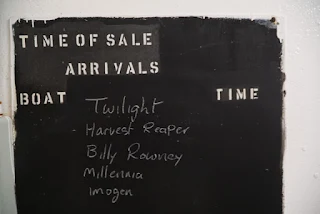A tad misleading with the netters Britannia V, Ajax, Lamorna, Little Pearl and New Harmony missing off the landing board...
as Monday's market is by far the biggest for the year...
top quality inshore fish from the Lizard...
numero uno megrim soles from the beamers...
along with monk - megs and monk make up the bulk of any beam trawl trip...
along with smatterings of Dover sole - the boats would land many more of these fish but under the present rigid quota system the boats are forced to dump tons of Dovers almost every trip - and it is not a fish easily avoided...
every ray has a unique, QCode like mark...
plaice come with orange and red spots
none of your £40,000 landings of cuttles in Newlyn needed to break port records, all eyes will be on the St Georges when she lands to see if Billy can wrestle the record back from relief skipper, Juicy, no pressure Bill ;-) ...
the frilly brill...
the not so frilly thornback ray's tail...
ahead by a short nose...
what to look for in fresh fish, bright, shiny eyes and blood-red gills...
black bream beauty...
Roger must have been smiling when these guys dropped out of the cod end on to the deck...
along with these cracking red mullet...
the other end of the market with nearly 1,500 boxes of big white fish...
so much fish that some of Ajax's trip was squeezed between the two market ends...
and the rest helped fill the rest...
and a good run of larger sizes was evident...
even the fridge was packed...
with mainly handline mackerel...
cod is often referred to as 'green', not hard to see why when it is this fresh...
and added bonus for the beam trawlers are big prime flat fish like these turbot...
not a breath over the harbour this morning...
and, apart from the sad and sorry Excellent, the only boats in port are those between trips...
as one of the shore crew make their way down the quay...
signs of an industry with enough faith to invest in new builds for the future, with the port's largest sardine boat nearing completion in the foreground for Stefan Glinski and Rowse's latest big crabber being fitted out and all lit up...
Newlyn is one of the port's who pioneered recycling old fishing nets - though a new startup company, @FishyFilaments is developing some amazing technology to convert these old nets into the raw materials used by 3D printers - you can do your own bit to help the environment by supporting the venture via their crowdfunding page - a great cause championed by a local business with the support of the fleet...
a step nearer the bus pass for Rose!
BTW this was fishing news from the far west of Cornwall post 6,500!















































